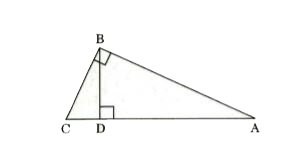In triangle ABC,∠BAC=90∘and AD is perpendicular to BC. If AD=6cmand BD=4cm, then the length of BC is:
10 cm
12 cm
13 cm
15 cm.
The correct Answer is:C
To find the length of BC in triangle ABC where ∠BAC=90∘, AD is perpendicular to BC, AD=6cm, and BD=4cm, we can follow these steps:
Step 1: Understand the triangle configuration
We have triangle ABC with A at the top, B on the left, and C on the right. Since ∠BAC=90∘, AB is vertical and AC is horizontal. AD is the height from A to line BC.
Step 2: Identify the segments
Since D is the foot of the perpendicular from A to BC, we know:
- AD=6cm (height from A to BC)
- BD=4cm (part of BC)
Let DC be the other part of BC. Thus, we can express BC as:
BC=BD+DC
Step 3: Use the Pythagorean theorem
To find AC and AB, we can apply the Pythagorean theorem in triangle ABD:
AB2=AD2+BD2
Substituting the known values:
AB2=62+42=36+16=52
Thus,
AB=√52=2√13cm
Step 4: Calculate AC using the tangent function
Using the right triangle ABD, we can find AC using the tangent function:
tan(∠ABD)=ADBD=64=32
This means that for every 2 units of BD, AD rises 3 units. Therefore, we can express AC in terms of AB:
AC=32×AB
Substituting AB=2√13:
AC=32×2√13=3√13cm
Step 5: Find DC
Now, we can find DC using the Pythagorean theorem in triangle ACD:
AC2=AD2+DC2
Substituting the values:
(3√13)2=62+DC2
This simplifies to:
117=36+DC2
Thus,
DC2=117−36=81⟹DC=√81=9cm
Step 6: Calculate BC
Now we can find the total length of BC:
BC=BD+DC=4+9=13cm
Final Answer
The length of BC is 13cm.
---
We have triangle ABC with A at the top, B on the left, and C on the right. Since ∠BAC=90∘, AB is vertical and AC is horizontal. AD is the height from A to line BC.
Since D is the foot of the perpendicular from A to BC, we know:
- AD=6cm (height from A to BC)
- BD=4cm (part of BC)
BC=BD+DC
To find AC and AB, we can apply the Pythagorean theorem in triangle ABD:
AB2=AD2+BD2
Substituting the known values:
AB2=62+42=36+16=52
Thus,
AB=√52=2√13cm
Using the right triangle ABD, we can find AC using the tangent function:
tan(∠ABD)=ADBD=64=32
This means that for every 2 units of BD, AD rises 3 units. Therefore, we can express AC in terms of AB:
AC=32×AB
Substituting AB=2√13:
AC=32×2√13=3√13cm
Now, we can find DC using the Pythagorean theorem in triangle ACD:
AC2=AD2+DC2
Substituting the values:
(3√13)2=62+DC2
This simplifies to:
117=36+DC2
Thus,
DC2=117−36=81⟹DC=√81=9cm
Now we can find the total length of BC:
BC=BD+DC=4+9=13cm
The length of BC is 13cm.
Topper's Solved these Questions
- GEOMETRYBOOK - KIRAN PUBLICATIONCHAPTER - GEOMETRYEXERCISE - QUESTIONS ASKED IN PREVIOUS SSC EXAMS (TYPE-IV)
35 Videos
- GEOMETRYBOOK - KIRAN PUBLICATIONCHAPTER - GEOMETRYEXERCISE - QUESTIONS ASKED IN PREVIOUS SSC EXAMS (TYPE-V)
30 Videos
- GEOMETRYBOOK - KIRAN PUBLICATIONCHAPTER - GEOMETRYEXERCISE - QUESTIONS ASKED IN PREVIOUS SSC EXAMS (TYPE-II)
25 Videos
- DISCOUNTBOOK - KIRAN PUBLICATIONCHAPTER - DISCOUNTEXERCISE - Test Yourself
10 Videos
- LCM AND HCF BOOK - KIRAN PUBLICATIONCHAPTER - LCM AND HCF EXERCISE - Test Yourself
18 Videos
Similar Questions
In a triangle ABC, ∠BCA=90∘ and CD is perpendicular to AB. If AD = 4 cm and BD = 9 cm, then the value of DC will be
View SolutionIn a △ABC, ∠BAC=90∘ and AD is perpendicular to BC where D is a point on BC. If BD = 4 cm and CD = 5cm then the length of AD is equal to:
△ABC में, ∠BAC=90∘ और AD, BC पर लंबवत है जहाँ D, BC पर एक बिंदु है। यदि BD =4 सेमी और CD =5 सेमी तो AD की लंबाई ज्ञात करे
View Solution
Knowledge Check
In ΔABC,∠BAC=90∘andAD is drawn perpendicular to BC . If BD -=7 cm and CD = 28 cm , what is the length (in cm ) of Ad ?
A3.5B7C10.5D14In ΔABC,∠BAC=90∘andAD is drawn perpendicular to BC . If BD -=7 cm and CD = 28 cm , what is the length (in cm ) of Ad ?
A3.5B7C10.5D14In ΔABC∠BAC=90∘ and ADI_BC. If BD=3cm and CD=4cm, then the length of AD is
A3.5 cmB5cmC2√3 cmD6cm
In the figure given below, ABC is a triangle with AB perpendicular to BC. Further BD is perpendicular to AC. If AD = 9 cm and DC = 4 cm, then what is the length of BD ?

View SolutionIn ΔABC, ∠A is right angle and AD is perpendicular to BC. If AD=4cm,BC=12cm, then value of (cotB+cotC)=
View SolutionABC is a triangle right angled at A and AD is perpendicular to BC. If BD = 8 cm and DC =12.5 cm, then what is AD equal to ?
View Solution∠Aof ΔABC is a right angle. AD is perpendicular on BC. If BC = 14 cm and BD = 5 cm, then measure of AD is :
View SolutionIn an isosceles triangle ABC with AB=AC and AD is perpendicular to BC, if AD=6 cm and the perimeter of ΔABC is 36 cm,, then the area of ΔABC is :
View Solution
